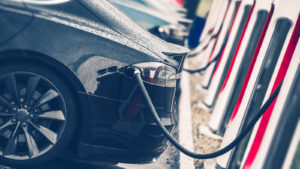What good is a car without a gas station?

Not much good at all. In fact, a car is pretty much useless as a means of transportation, unless it has fuel. Fuel comes from gas stations. No gas stations. No usable cars.
By that same token, what good is an electric car without a charging station?
Not much good, either. An EV runs on electric charge. If that charge runs up – and there’s nowhere to refill the charge – then the EV won’t go anywhere… no charging stations, no usable EVs.
From this perspective, the EV megatrend that everyone is gushing about – you know, the one wherein everyone and their best friend buys a Tesla or some other electric car over the next decade – won’t come to be unless an equally large growth spurt materializes in EV charging infrastructure.
And that’s exactly what will happen…
Over the next decade, the number of EV charging stations globally will explode from a few thousand, to a few MILLION, as every car on the road gets electrified.
As that happens, relatively tiny EV charging companies, will turn into global charging giants.
So… time to buy EV charging stocks, right?
Not so fast.
There are lots of EV charging companies out there today. Not all of them will make it. Indeed, only a handful of them will make it big. Most will fail. So, it’s not time to buy EV charging stocks – rather, it’s time to buy the best EV charging stocks.
And to know which ones are “the best,” we need to first understand EV charging technology.
That analysis starts with the fundamental question: How does electricity work?
In short, we generate power at a power source, like a coal-fired power plant or a solar farm, and then promote the flow of electrons (little charged particles that carry electric power) from that power source to the rest of the world via electric wires. This flow of electrons is called a “current.”
That current can take two forms: Alternating current (AC) or direct current (DC). DC is a direct constant flow of electrons through the wire. It results in heavy power delivery, but also in significant drain on the grid. AC is an oscillating flow of electrons that results in lower power delivery, but a much more manageable load on the grid.
Because the grid is and has always been load-constrained, society decided long ago to build the grid on AC. But today’s batteries can only store power as DC – since AC being alternating physically makes it unable to store.
That’s why most consumer electronics devices – like laptops – come with power chords that have big boxes in the middle of them. Those big boxes are AC/DC converters which convert the AC power from the grid, to DC power that can be stored in your laptop.
EV charging works in much the same way.
EV chargers plug into the grid, which provides AC power. That AC power is then pumped into the EV. On board every EV, there is an AC/DC converter which converts the AC power from the charger, into usable DC power, which is then stored in the car’s battery.
There are two classifications of AC chargers – L1 and L2.
L1 chargers are the most basic chargers out there. They’re really slow, but really cheap. They’ll give you about three to five miles of EV range per hour of charging. Given that they’re low-cost, low-performance in nature, L1 chargers are common as residential solutions, but are very rarely used beyond the home.
L2 chargers are a big step-up from L1 chargers. They’re much faster, but also much more expensive. They’ll give you maybe 30 miles of EV range per hour of charging. These L2 chargers constitute the majority of chargers on the road today.
Full story on InvestorPlace.com




Leave a Comment